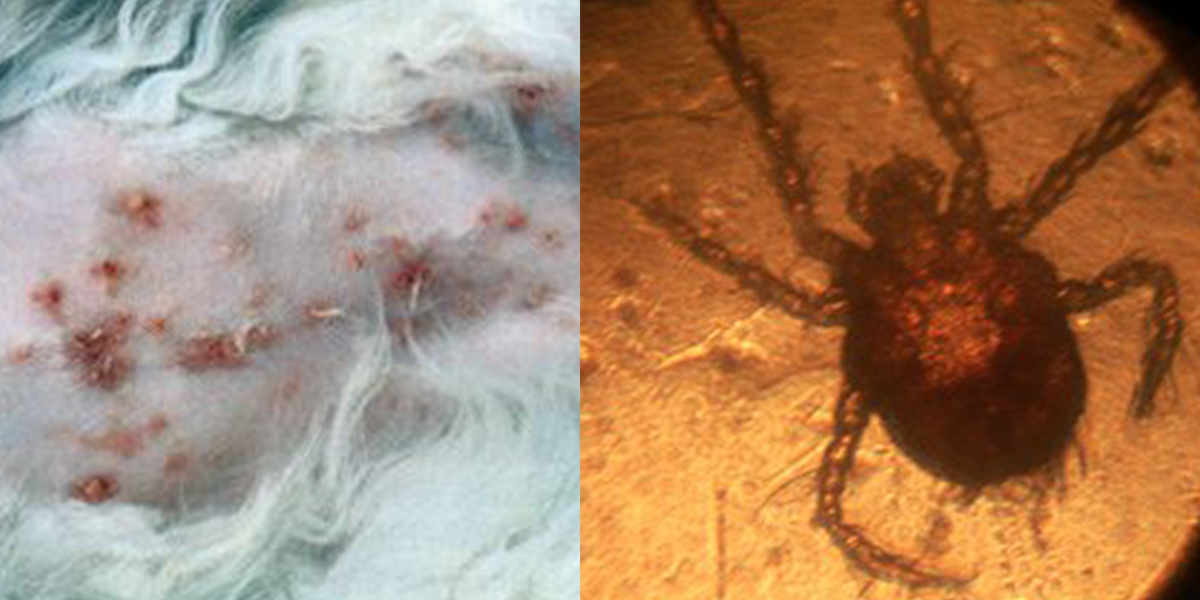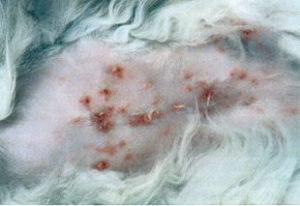Harvest mites, harvest bugs or bracken bugs are the names popularly given to the larvae of the mite Trombicula autumnalis.

The adult mite is an eight-legged mite that lives in vegetation, but the six-legged larvae are parasitic and live on mammals (including humans and cats) and birds. The larvae feed on tissue fluid and often cause considerable skin itching and discomfort (in both humans and cats) in the late summer and autumn.
The orange/yellow larvae are around 0.2mm long and widely distributed throughout the world, although not present in all climates or regions. Larvae are initially only just visible to the naked eye, but they swell to about three times their original size when they have finished feeding.
Life cycle
The first active stage in the life cycle of Trombicula is the six-legged larval (see picture) period, which is the only stage that attacks animals. These larvae are present on vegetation and are active during the day, especially when it is dry and sunny. When they come into contact with any warm blooded animal they swarm on and congregate in areas where there is little hair and the skin is quite thin. This usually occurs especially towards the end of summer.
The larva feeds by thrusting its small hooked fangs into the surface layers of the skin, and then injects a fluid to break down the cells. The liquid food resulting from this process is sucked back into the digestive system of the larva. It will inject and suck for two to three days at the same site until it has increased in size three to four times. The larva then drops to the ground to complete its life cycle. It descends into the soil and after about six weeks becomes an eight-legged nymph and then an adult which eats plants and small insects. Eggs laid by the adult in the spring and summer hatch into the six-legged larva (known as harvest mites) and the cycle starts again.
Dermatitis (skin inflammation) caused by harvest mites
When larvae inject fluid into the skin, this can cause a severe skin reaction in sensitive individuals. In humans, this can show as small inflamed pimples. In cats the irritation typically causes reddening of the skin, papules and crusted areas. The areas most likely to be affected are the base of the ears (Henry’s pocket – the little pocket of skin on the side of the pinna of the ear), the face (especially the chin and around the mouth), the neck and shoulders, under the front legs, on the abdomen and around the nipples, vulva and scrotum and between the toes – any area where there is only a thin covering of hair.
Scratching, which may dislodge the mites (until more attach), can result in injury to the skin and in severe cases raw areas can develop. These areas can become secondarily infected with bacteria.
Diagnosis
Diagnosis is made by observation and identification of the larvae through the microscope. Your vet will have to take a skin scraping to see the larvae and make a definitive diagnosis. It is best to take your cat to the vet as soon as you see any suspicious signs as the larvae can drop off quite quickly.
Treatment
Some flea treatments available from your vet will be effective in treating Harvest mites, but treatment should always be carried out under the direction of your vet. A cat which appears to be hypersensitive to the mite may also need glucocorticoid therapy for a short period, to relieve the itching, until the mites have reduced in number.
Thank you for visiting our website, we hope you have found our information useful.
All our advice is freely accessible to everyone, wherever you are in the world. However, as a charity, we need your support to enable us to keep delivering high quality and up to date information for everyone. Please consider making a contribution, big or small, to keep our content free, accurate and relevant.
Support International Cat Care from as little £3
Thank you.
Donate Now



